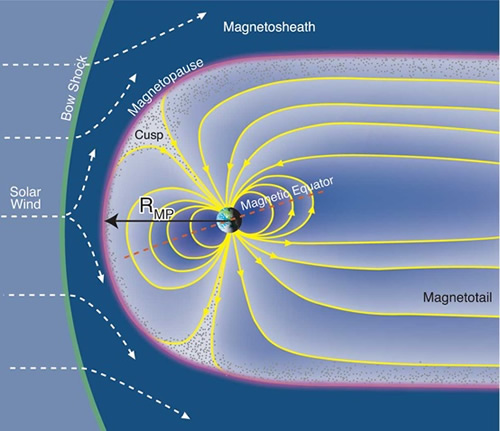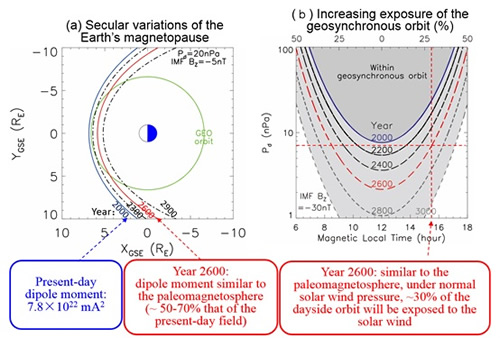The Earth’s magnetosphere is formed by the interaction of the solar wind with Earth’s dipole magnetic field. The boundary between the solar wind and Earth’s magnetic field is called the magnetopause. This boundary separates the magnetospheric plasma from the solar wind and determines the size of the magnetosphere (Figure 1). It plays a crucial role in protecting Earth from the harmful effects of the solar wind.  The location of the magnetopause generally depends on the total pressure balance across the boundary. Typically, the
The location of the magnetopause generally depends on the total pressure balance across the boundary. Typically, the  subsolar magnetopause is located at ~10 RE (Earth radii) from the Earth. However, during space weather events, the magnetopause can move closer and even cross the
subsolar magnetopause is located at ~10 RE (Earth radii) from the Earth. However, during space weather events, the magnetopause can move closer and even cross the  line of geosynchronous orbit (6.6 RE). Some dayside geosynchronous satellites would be exposed directly to the solar wind and may experience anomalies, damage, or even loss.
line of geosynchronous orbit (6.6 RE). Some dayside geosynchronous satellites would be exposed directly to the solar wind and may experience anomalies, damage, or even loss.
To predict the magnetopause location, various empirical models have been developed over the  past few decades. Generally, those models are obtained by using in situ magnetopause crossings data to fit analytic functions describing the geometry of the magnetopause. These analytic models are commonly
past few decades. Generally, those models are obtained by using in situ magnetopause crossings data to fit analytic functions describing the geometry of the magnetopause. These analytic models are commonly  parameterized by the solar wind conditions, e.g., the solar wind dynamic pressure (Pd) and/or north-south component of the interplanetary magnetic field (IMF BZ). Up to now, almost all previously available magnetopause models are focused on the present-day magnetosphere, and the practicability of those models
parameterized by the solar wind conditions, e.g., the solar wind dynamic pressure (Pd) and/or north-south component of the interplanetary magnetic field (IMF BZ). Up to now, almost all previously available magnetopause models are focused on the present-day magnetosphere, and the practicability of those models  relies largely on the fitted real-time
relies largely on the fitted real-time  in situ data. The dipole moment, however, has been steadily decreasing at a rate of 5–7% per century since measurements began in 1840. If this declining trend continues,
in situ data. The dipole moment, however, has been steadily decreasing at a rate of 5–7% per century since measurements began in 1840. If this declining trend continues, 


 on timescales larger than decades, the magnetosphere will shrink and the chance of geosynchronous magnetopause crossings will increase.
on timescales larger than decades, the magnetosphere will shrink and the chance of geosynchronous magnetopause crossings will increase.
Zhong et al. developed a magnetopause location model that is parameterized by both the Earth’s dipole moment and the solar wind conditions, and investigated the influence of the decreasing dipole moment on the average magnetopause location. The results show that, if the declining dipole trend continues, the average subsolar magnetopause distance would move earthward by 2000 km per century (Figure 2a). They also quantitatively evaluated the increasing exposure of geosynchronous orbit in the solar wind caused by the decay of dipole moment and the variation of solar wind conditions, and studied the possible situation  if such decay persists for several more centuries. The minimum solar wind dynamic pressure required for geosynchronous magnetopause crossings will decrease by ~4 nPa (2 nPa) in the next 100 years under northward (southward) interplanetary magnetic field. The simulated situations in the next 6 centuries may be similar with that of the paleomagnetosphere at 3.4 to 3.45 billion years ago when the geomagnetic field strength was about 50-70% that of the present-day field. Even under the normal solar wind conditions,
if such decay persists for several more centuries. The minimum solar wind dynamic pressure required for geosynchronous magnetopause crossings will decrease by ~4 nPa (2 nPa) in the next 100 years under northward (southward) interplanetary magnetic field. The simulated situations in the next 6 centuries may be similar with that of the paleomagnetosphere at 3.4 to 3.45 billion years ago when the geomagnetic field strength was about 50-70% that of the present-day field. Even under the normal solar wind conditions,  30% of the dayside geosynchronous orbit will be exposed to the solar wind (Figure 2b). These results suggest that the secular variations of geomagnetic field are of paramount importance for our understanding of space climate.
30% of the dayside geosynchronous orbit will be exposed to the solar wind (Figure 2b). These results suggest that the secular variations of geomagnetic field are of paramount importance for our understanding of space climate.

Figure 1. Earth magnetosphere: basic dipolar magnetosphere with distance to subsolar magnetopause (RMP).

Figure 2. (a) The secular variations of the magnetopause location from the model; (b) the increasing exposure of  geosynchronous orbit in the solar wind caused by the decay of dipole moment and the variation of solar wind condition. Each line, corresponding to the predicted dipole moment at a given year, represents the magnetic local times of geosynchronous orbit crossings as a function of the solar wind dynamic pressure Pd. The region above each line (shaded) represents the magnetic local times of orbit that exposed in the solar wind. The calculated exposure ratios of the orbit are shown in the upper axis of the figure.
geosynchronous orbit in the solar wind caused by the decay of dipole moment and the variation of solar wind condition. Each line, corresponding to the predicted dipole moment at a given year, represents the magnetic local times of geosynchronous orbit crossings as a function of the solar wind dynamic pressure Pd. The region above each line (shaded) represents the magnetic local times of orbit that exposed in the solar wind. The calculated exposure ratios of the orbit are shown in the upper axis of the figure.
This study has published in January 2015 in the Journal of Geophysical Research:Space Physics(Zhong, J. et al. Increasing exposure of geosynchronous orbit in solar wind due to decay of Earth's dipole field, Journal of Geophysical Research: Space Physics, 2014, 119: 9816–9822)(Link)